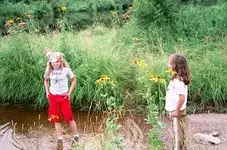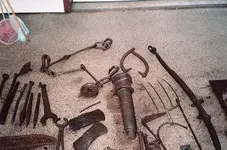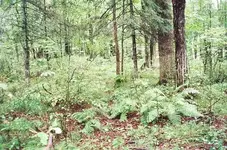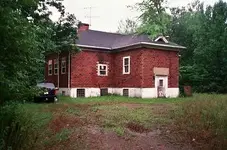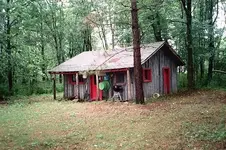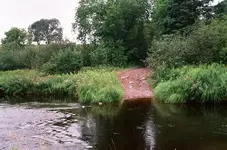Gypsy Heart
Gold Member
- #1
Thread Owner
Gypsy's Ghost Town Hunt 9/10 pics added
Tomorrow I end a journey that has taken me ten years to accomplish. Next week I hope to post my finds and the rest of the story. ........................
You could hear it long before you saw it. The gentle rushing of cool water rambling lazily over the rocks of the Jump River. Traveling down the rutted, dusty lane, surrounded by towering pines, oaks and cedar, the air was pungent with the warm rich smell of ancient woods. This road has remained the same for over 150 years. Spiraling slivers of sunlight peeked through the dense undergrowth, allowing fleeting glimpses of the moss-covered floor of the forest. Dark shadows beckoned you deeper. Shifting the Jeep to a crawl, I allowed myself to travel back in time and experience how the early settlers felt, as they took this same road to their new homes for the very first time.
Fourteen ox driven carts, 56 people, including women and small children had just arrived from Eastern NY. The journey had taken over five months, and it was now midsummer. Tired and dirty, but full of hope they marveled at the vastness of the Wisconsin Northwood’s. These pioneers were to become landowners. At 1 cent an acre, the government had promised all settlers that the Northern acreage could become theirs if they established homesteads. Banding together, these brave young men and women, babies and grandparents had journeyed North West to fulfill their dreams. The young men, tall handsome Swedes and Norwegians had already called claims to their land, as they had passed them. Following the Indian trails that ran along the river, each family positioned themselves on high ground, with the water close by.
The Cummings, Vannedges, Millers, Kubes, Fricks ,Andersons to name a few would within a short time have the land cleared, log homes and barns built and a town began. A bustling settlement, with feed and grain mill, a sawmill, general store, several homes, livery ,a coopers and school. A river mill town that provided unity and life to the families and those that would soon follow. Soon this small community would boast two hundred people. A town with hopes…… that would eventually fade into the forest floor as the railroads took over in the 1900’s and the river towns became a graveyard of dreams. The birth and death of a town within a fifty-year span. If you listen, you can hear the wailing of a faraway train whistle, sending its mournful death cry over the hills and echoing its haunting sound throughout the treetops.
Within these overgrown woods, are the remnants of that town. As long as I can remember, stories were told of the mighty loggers who cleared the Wisconsin forests, turning them to rich farm ground and making the way for the huge dairy farms. This road will end the search.
Last fall, I was able to pinpoint the town’s location. There are few existing records. The children and grandchildren of these settlers are long buried and the remaining families, now in their 70 ands 80’s vaguely remember the stories they were told. For many years I was led to believe, this was just a way station, not really a town. But things didn’t add up, the more I sought, the more I found. Bits and pieces of information gathered from old pictures, journals, school records, books and maps.
The one remaining building is the brick school. Burned twice, this was the heart of the community. It has now stood steadily since the 1880’s. The Cummings brothers donated land for the building of the school within the first year of settlement. Education was important and first little log school housed not only their children, but became the community center, as it served as a church, dances were held here, as well as weddings and funerals. Children were brought to school by boat, sled and wagons.
The first winter was hard, but the Indians tribes provided the settlers with food, venison and friendship. These friendships turned to family as many of the young men took Indian brides. The Indians had a huge Camp 15 miles to the East of the settlement and trading of goods was a common occurance in the small village. Each spring, the tribe would make their way through the little town, trading furs and hides ,dried herbs, copper tools and other staples for the items they needed. These Indians had traveled down from Eau Claire and brought items to the small village that the white people needed.
The Cummings brothers cleared over 300 acres of pines the within three years. New York Timber barons purchased the great white pines and a sawmill was established on the Jump. Within that time a settlement sprang up, with the next closest being Ogema, 20 miles as the crow flies.
As you breath in the glory of this place, you can see why and how a family could make a good life here. The woods are thick, the water plentiful and the ground, dark and rich. Abundant wild game and fish are evident still.
My job has just begun. It is my plan to grid and hunt this land over the next five days. I have sought permission from several out of state land-owners and will be camping here, while documenting everything I find. A book for the State Historical Society as well as the County will be published by fall. I had previously surveyed this spot and have found rock foundations and cellar holes on both sides of the river. A farm owner, descendant from the first Cummings, will meet with me to show where he buried several other foundations fifty years ago. I will be canoeing two miles up river to photograph several settlers and a trappers log cabins. I have found several bottle dumps along the river in a short period and the remains show dates of 1850’s, some as old as 1830’s. My first find, deep into the woods, was a rusted cast iron cook stove, a tombstone marking the demise of a forgotten time and place.
Research …is like a homesteaders quilt…you save every scrap ,no matter how tiny , but as you begin to put the pieces together ,you end up with a beautiful story of someones life.
I cannot let the dreams and hopes of these first settlers fade into oblivion. They need to be honored as important people of our history. They might not have been famous or world known. They didn’t become Generals or Presidents. The small items I hope to find ,wont lead to anything of historical exclamation. But these are my people ….and yours…..Our brave and fearless ancestors who paved the way across the States for each of us. Lets step back into time and glimpse into their hearts and souls.
Day One: ………………..to be continued
Tomorrow I end a journey that has taken me ten years to accomplish. Next week I hope to post my finds and the rest of the story. ........................
You could hear it long before you saw it. The gentle rushing of cool water rambling lazily over the rocks of the Jump River. Traveling down the rutted, dusty lane, surrounded by towering pines, oaks and cedar, the air was pungent with the warm rich smell of ancient woods. This road has remained the same for over 150 years. Spiraling slivers of sunlight peeked through the dense undergrowth, allowing fleeting glimpses of the moss-covered floor of the forest. Dark shadows beckoned you deeper. Shifting the Jeep to a crawl, I allowed myself to travel back in time and experience how the early settlers felt, as they took this same road to their new homes for the very first time.
Fourteen ox driven carts, 56 people, including women and small children had just arrived from Eastern NY. The journey had taken over five months, and it was now midsummer. Tired and dirty, but full of hope they marveled at the vastness of the Wisconsin Northwood’s. These pioneers were to become landowners. At 1 cent an acre, the government had promised all settlers that the Northern acreage could become theirs if they established homesteads. Banding together, these brave young men and women, babies and grandparents had journeyed North West to fulfill their dreams. The young men, tall handsome Swedes and Norwegians had already called claims to their land, as they had passed them. Following the Indian trails that ran along the river, each family positioned themselves on high ground, with the water close by.
The Cummings, Vannedges, Millers, Kubes, Fricks ,Andersons to name a few would within a short time have the land cleared, log homes and barns built and a town began. A bustling settlement, with feed and grain mill, a sawmill, general store, several homes, livery ,a coopers and school. A river mill town that provided unity and life to the families and those that would soon follow. Soon this small community would boast two hundred people. A town with hopes…… that would eventually fade into the forest floor as the railroads took over in the 1900’s and the river towns became a graveyard of dreams. The birth and death of a town within a fifty-year span. If you listen, you can hear the wailing of a faraway train whistle, sending its mournful death cry over the hills and echoing its haunting sound throughout the treetops.
Within these overgrown woods, are the remnants of that town. As long as I can remember, stories were told of the mighty loggers who cleared the Wisconsin forests, turning them to rich farm ground and making the way for the huge dairy farms. This road will end the search.
Last fall, I was able to pinpoint the town’s location. There are few existing records. The children and grandchildren of these settlers are long buried and the remaining families, now in their 70 ands 80’s vaguely remember the stories they were told. For many years I was led to believe, this was just a way station, not really a town. But things didn’t add up, the more I sought, the more I found. Bits and pieces of information gathered from old pictures, journals, school records, books and maps.
The one remaining building is the brick school. Burned twice, this was the heart of the community. It has now stood steadily since the 1880’s. The Cummings brothers donated land for the building of the school within the first year of settlement. Education was important and first little log school housed not only their children, but became the community center, as it served as a church, dances were held here, as well as weddings and funerals. Children were brought to school by boat, sled and wagons.
The first winter was hard, but the Indians tribes provided the settlers with food, venison and friendship. These friendships turned to family as many of the young men took Indian brides. The Indians had a huge Camp 15 miles to the East of the settlement and trading of goods was a common occurance in the small village. Each spring, the tribe would make their way through the little town, trading furs and hides ,dried herbs, copper tools and other staples for the items they needed. These Indians had traveled down from Eau Claire and brought items to the small village that the white people needed.
The Cummings brothers cleared over 300 acres of pines the within three years. New York Timber barons purchased the great white pines and a sawmill was established on the Jump. Within that time a settlement sprang up, with the next closest being Ogema, 20 miles as the crow flies.
As you breath in the glory of this place, you can see why and how a family could make a good life here. The woods are thick, the water plentiful and the ground, dark and rich. Abundant wild game and fish are evident still.
My job has just begun. It is my plan to grid and hunt this land over the next five days. I have sought permission from several out of state land-owners and will be camping here, while documenting everything I find. A book for the State Historical Society as well as the County will be published by fall. I had previously surveyed this spot and have found rock foundations and cellar holes on both sides of the river. A farm owner, descendant from the first Cummings, will meet with me to show where he buried several other foundations fifty years ago. I will be canoeing two miles up river to photograph several settlers and a trappers log cabins. I have found several bottle dumps along the river in a short period and the remains show dates of 1850’s, some as old as 1830’s. My first find, deep into the woods, was a rusted cast iron cook stove, a tombstone marking the demise of a forgotten time and place.
Research …is like a homesteaders quilt…you save every scrap ,no matter how tiny , but as you begin to put the pieces together ,you end up with a beautiful story of someones life.
I cannot let the dreams and hopes of these first settlers fade into oblivion. They need to be honored as important people of our history. They might not have been famous or world known. They didn’t become Generals or Presidents. The small items I hope to find ,wont lead to anything of historical exclamation. But these are my people ….and yours…..Our brave and fearless ancestors who paved the way across the States for each of us. Lets step back into time and glimpse into their hearts and souls.
Day One: ………………..to be continued




